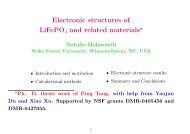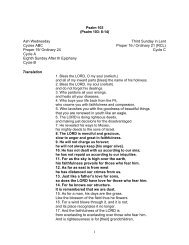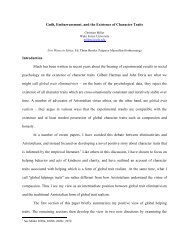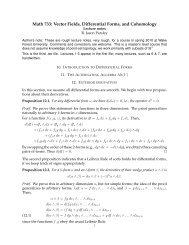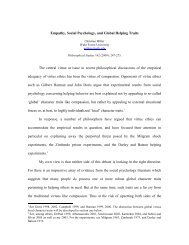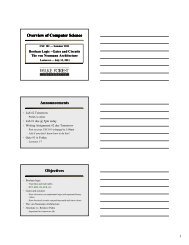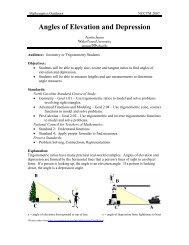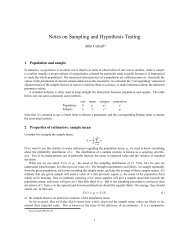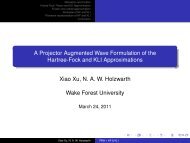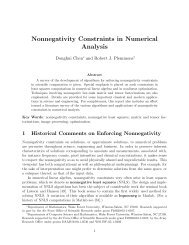Keynes, Ricardo, Malthus and Say's Law - Wake Forest University
Keynes, Ricardo, Malthus and Say's Law - Wake Forest University
Keynes, Ricardo, Malthus and Say's Law - Wake Forest University
Create successful ePaper yourself
Turn your PDF publications into a flip-book with our unique Google optimized e-Paper software.
<strong>Ricardo</strong> says that accumulation is limited only by profitability.With this <strong>Keynes</strong> could agree : in his theory investmentis not limited by dem<strong>and</strong> ; rather investment itselfconstitutes the proximate limit on dem<strong>and</strong>, via the multiplier.Where the two part company, however, is over <strong>Ricardo</strong>’s furtherclaim that the only serious restriction on the profitabilityof investment lies in diminishing returns in agriculture. For<strong>Keynes</strong> the profitability of real investment is the combinedeffect of the level of the schedule of the marginal efficiencyof capital <strong>and</strong> the money rate of interest, where the latterhas a ‘‘life of its own’’ <strong>and</strong> is not merely a reflection of a pregivenlevel of real profitability. <strong>Keynes</strong>ian unemploymentarises when the configuration of the MEC schedule <strong>and</strong> therate of interest is such that the resulting level of investmentfalls short of the saving that would be generated out of thefull-employment level of income. It’s not that investment islimited by dem<strong>and</strong>, as in Smith <strong>and</strong> <strong>Malthus</strong> : production islimited by dem<strong>and</strong>, but this is because the rate of interest istoo high to generate a volume of investment that correspondsto full-employment saving.v conclusionThe <strong>Malthus</strong>–<strong>Ricardo</strong> debate was essentially conductedon the terrain of a barter economy ; <strong>and</strong> on this terrain therecan be little doubt that <strong>Ricardo</strong> was right. <strong>Keynes</strong> said hewished that <strong>Malthus</strong> had won the debate with <strong>Ricardo</strong>. Butas the debate actually played out, had <strong>Malthus</strong> been perceivedas the victor this would simply have reflected badly on thelogical acumen of the audience. <strong>Keynes</strong>’s critique of Say’s<strong>Law</strong> depends essentially—as the title of his book remindsus—on issues of interest <strong>and</strong> money ; these were not in playin <strong>Malthus</strong>, <strong>and</strong> it is only with <strong>Keynes</strong>ian hindsight, <strong>and</strong> witha large benefit of the doubt, that <strong>Malthus</strong> can be credited withreal insight. ‘‘Surely it was a great fault in <strong>Ricardo</strong> to fail tosee any significance in [<strong>Malthus</strong>’s] line of thought,’’ wrote<strong>Keynes</strong> (1963, p. 123). But what <strong>Keynes</strong> is really saying,it seems to me, is that he wishes <strong>Ricardo</strong> had been able todiscern in <strong>Malthus</strong>’s erroneous <strong>and</strong> incoherent objections toSay’s <strong>Law</strong> the outline of the quite different critique that wasto be advanced by <strong>Keynes</strong> himself over a century later. Thatis asking too much !referencesBaumol, W. 1977. ‘‘Say’s (at Least) Eight <strong>Law</strong>s, or WhatSay <strong>and</strong> James Mill May Really Have Meant’’. Economica,May, pp. 145–61.Clower, R. W. <strong>and</strong> A. Leijonhufvud 1973. ‘‘Say’s Principle,What It Means <strong>and</strong> Doesn’t Mean’’. Intermountain EconomicReview, Fall. Reprinted in A. Leijonhufvud, Information<strong>and</strong> Coordination. New York : Oxford <strong>University</strong>Press, 1981.Cottrell, A. 1994. ‘‘<strong>Keynes</strong>’s Appendix to Chapter 19 : AReader’s Guide’’. History of Political Economy 26 :4, pp.681–95.<strong>and</strong> M. S. <strong>Law</strong>lor 1991. ‘‘ ‘Natural Rate’ Mutations: <strong>Keynes</strong>, Leijonhufvud <strong>and</strong> the Wicksell Connection’’.History of Political Economy 23:4, pp. 625–43.Hutt, W. H. 1974. A Rehabilitation of Say’s <strong>Law</strong>. Athens,OH : Ohio <strong>University</strong> Press.Jonsson, P. O. 1997. ‘‘On Gluts, Effective Dem<strong>and</strong> <strong>and</strong> theTrue Meaning of Say’s <strong>Law</strong>’’. Eastern Economic Journal(forthcoming).Kalecki, M. 1954. ‘‘The Determinants of Profits’’. In hisTheory of Economic Dynamics. London : George Allen<strong>and</strong> Unwin.Kates, S. 1997. ‘‘On the True Meaning of Say’s <strong>Law</strong>’’. EasternEconomic Journal (forthcoming).<strong>Keynes</strong>, J. M. 1936. The General Theory of Employment, Interest<strong>and</strong> Money. London : Macmillan.. 1963. Essays in Biography. New York : Norton.Marx, K. 1976. Capital, volume i, Harmondsworth : Penguin.17 18



